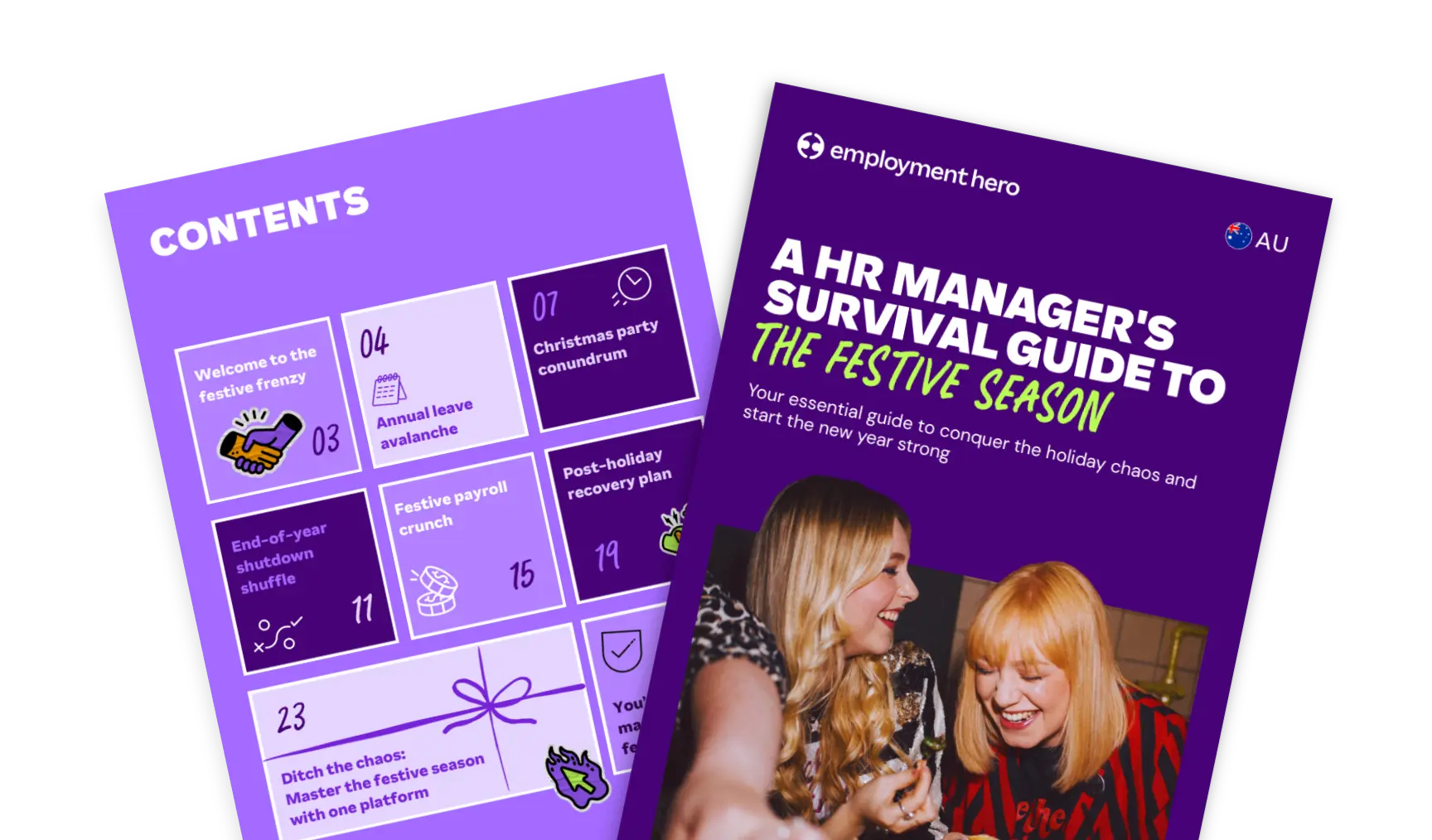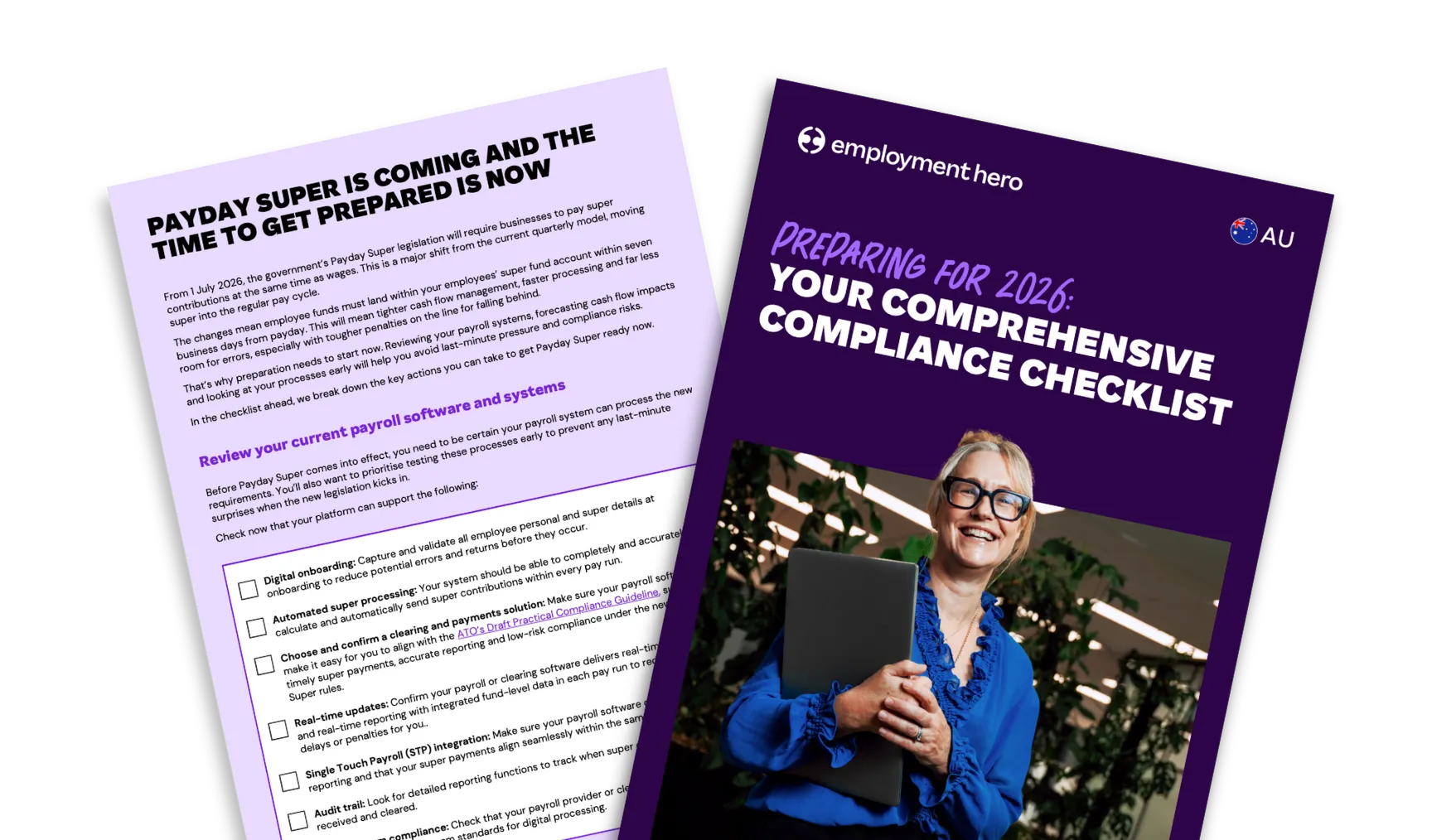Learning and Development strategy guide
Published
Learning and Development strategy guide
Published
2 min read
Your people are your biggest asset. This guide will help you build a learning strategy that’s practical, scalable, and aligned with what your team and your business really need.
What’s in this guide?
Learning and Development (L&D) is important, but turning that intention into a clear, effective business strategy is where most teams get stuck. Whether you’re starting from scratch or levelling up an existing program, this guide gives you the clarity, confidence, and structure to make learning a real business driver.
In this guide you’ll find:
- Why learning and development is important: We’ve unpacked the business case for L&D. You’ll learn how strategic investment in learning boosts engagement, drives retention, and builds future-ready teams, even in lean environments.
- What skills do employees need for the future: The world of work is changing fast. This section helps you identify which new skills matter most, so you can future-proof your workforce and close skills gaps before they cost you.
- The best methods of learning: Not all learning is created equal. We break down a range of formats including on-the-job training, digital learning, workshops, mentoring, and more, so you can design programs that meet learners where they are (and actually stick).
- The role of coaching in L&D: Training can spark growth, but coaching sustains it. Discover how to embed coaching into your L&D strategy, even without a big budget or in-house expertise, and why it’s often the missing link in long-term development.
- How to create and implement a smart L&D strategy: You’ll get a step-by-step framework to move from reactive training to proactive development. From setting goals to measuring impact, this section walks you through building a strategy that scales and shows results.
Need help bringing your learning strategy to life? Our Learning Management System (LMS) is designed to support you and your team with a range of courses available on-demand. Looking for something more custom? You can create your own course material and assign it to your team, along with quizzes to assess their knowledge.
Why is talent development important?
In a competitive market where top talent has options, businesses that invest in talent development are more likely to retain them. That’s because today’s employees aren’t satisfied with static roles. They’re looking for growth, meaningful contributions, and development opportunities that support their career aspirations.
A well-structured talent development strategy not only fuels individual ambition but also enables organisations to continually adapt in changing markets, driving long-term performance and agility at scale.
So, what does this actually look like in practice? Below are the key pillars of a strong talent development program, and how each one helps solve real business and workforce challenges.
Ensuring career development for retention rates
Competitive remuneration alone is no longer enough to secure long-term commitment, as employees are looking for growth, direction, and opportunities for career progression. By providing clear development pathways, organisations demonstrate that they value internal mobility and long-term potential.
It’s a win-win: your team gains clarity, and you retain top performers who might otherwise look elsewhere.
Ensuring continuous learning for high performance
Organisations that embed continuous learning into their operations empower employees to stay agile in the face of change. From upskilling and cross-training to formal learning pathways and informal learning opportunities, consistent development equips teams to develop critical skills that drive innovation. This commitment to knowledge sharing and lifelong learning creates resilient teams capable of navigating industry shifts.
Ensuring leadership training
Strong leadership is one of the most influential drivers of organisational performance, yet many businesses struggle to build a reliable pipeline of leadership talent.
Proactive leadership development, overseen by the likes of Learning and Development Managers or even a Chief Learning Officer, and implemented through targeted training, coaching, or mentoring, prepares individuals to lead with clarity, empathy, and strategic foresight.
By investing early, organisations safeguard their future and create continuity through change.
Identifying and addressing skill gaps through structured training
Skill gaps are often the silent barrier to productivity and growth, and are often revealed through missed targets, employee frustration, or inconsistent performance. Without a proactive learning and development strategy, these gaps can widen, impacting business outcomes and limiting team effectiveness.
Talent development plays a critical role here: through skills audits, performance data, and structured feedback loops. From here organisations can identify where capabilities fall short, and respond with targeted training programs and skill-building initiatives that address both immediate needs and long-term capability gaps.
Rather than relying on ad hoc fixes, L&D offers a systematic, forward-looking approach to closing skill gaps and building long-term capability across the workforce
Fostering a culture of growth and adaptability
When learning is encouraged, recognised, and modelled at every level, it becomes part of how the business operates. This kind of culture builds resilience, supports innovation, and gives employees the confidence to take initiative in the workplace.
What are learning management systems?
An employee learning management system is software that streamlines training delivery, knowledge sharing, and on-demand learning across your organisation. It serves as the infrastructure supporting your learning and development efforts, housing everything from onboarding modules and compliance training to leadership development and skills-based learning.
For Human Resources (HR) and L&D teams, it brings structure, consistency, and visibility to initiatives that might otherwise be difficult to scale, particularly for critical areas like safety training and compliance.
Internally, an LMS is used to support employee development across the board, whether it’s onboarding new hires, upskilling existing staff, or ensuring compliance with industry regulations. It can also be used to manage learning for non-permanent workers, such as independent contractors or freelancers, ensuring everyone aligned with the business receives consistent, up-to-date training.
Consider a few common use cases:
- A professional services firm uses its LMS to deliver mandatory ethics and compliance training across multiple regions and track completion for audit purposes.
- An HR team delivers training to external contractors through the same LMS used for employees, creating a centralised, trackable system for onboarding and compliance.
Beyond delivery, LMS platforms also empower employees. Most systems are designed for self-directed learning, allowing users to explore relevant courses, revisit materials, and track their own progress, making learning more accessible and engaging.
So what types of LMS exist, and how do you choose the right one for your organisation? The answer depends on your team size, training goals, level of in-house support, and how learning integrates with your broader HR strategy. Whether you’re building a development framework from scratch or enhancing an existing program, understanding the various LMS options is crucial for making an informed decision.
How to measure the success of your L&D strategy
Creating a learning and development strategy is only the first step. To ensure it delivers meaningful impact, you need a way to measure its effectiveness, both in terms of employee outcomes and business value.
Without clear metrics, even the best-designed programs risk being undervalued or underfunded. Effective learning strategies typically lead to improved employee engagement, which can be measured through satisfaction surveys, participation rates, and retention metrics.
That’s why evaluation is a critical part of every L&D strategy: it turns activity into insight, and insight into improvement. Here are four key ways to evaluate the impact of your L&D strategy:
Tracking learning engagement and completion
Start with the basics: are employees participating in training, and are they completing it? Metrics like enrolment rates, completion percentages, assessment scores, and time spent learning can help gauge whether your content is engaging and accessible. High participation often reflects well-designed learning, but it’s only one piece of the picture.
Assessing knowledge application and performance
Training is only effective if it changes behaviour or improves performance. Use post-training assessments, observation, and manager feedback to understand whether employees are applying what they’ve learned. You might also track improvements in task accuracy, speed, or problem-solving ability to measure skill uptake on the ground.
Gathering learner feedback and experience insights
While metrics give you the “what,” learner feedback gives you the “why.” Use surveys, pulse checks, and team discussions to uncover how employees felt about the learning experience. Was the content relevant? Did the format work? Were there gaps? Qualitative insights help refine your programs and keep them learner-centric.
Measuring business impact and demonstrating ROI
Ultimately, learning should support business goals. Look for shifts in broader performance metrics such as faster onboarding times, improved customer satisfaction, higher retention, or fewer compliance issues. These indicators help you tell a compelling story about L&D’s value, especially when reporting to leadership. Framing learning outcomes in commercial terms positions L&D as a strategic driver of organisational growth.
What does a professional development strategy look like?
If you’re thinking beyond ad hoc training sessions and one-off workshops, you’re already on the right track. A well structured professional development strategy helps you connect learning to business goals, give employees clear direction, and build capability in a way that’s scalable and sustainable.
The good news? You don’t need to have all the answers from day one. A strong strategy evolves with your business, and this section will walk you through what it looks like in practice.
So, what goes into a well-designed professional development strategy, and how can you shape one that works for your people and your business?
Aligning development with business goals and measuring success
A strong development strategy starts with clarity, i.e., knowing what your organisation is trying to achieve and aligning learning initiatives to support those goals. This requires collaboration between HR teams and business leaders to ensure training investments directly address strategic priorities and capability gaps.
Setting clear KPIs early on ensures your L&D programs stay focused and accountable. From productivity improvements to engagement metrics, these indicators help you track progress, report impact, and continually refine your approach as business needs evolve.
Mapping learning pathways across roles
Everyone’s learning journey looks different. A thoughtful development strategy should account for differences and outline clear learning pathways based on role, level, and future potential. Whether it’s onboarding for new hires, technical upskilling, or preparing high performers for leadership roles, the goal is to help people see where they’re headed and how to get there.
Offering a mix of learning formats
Not every skill is learned in a classroom, and not every team member learns the same way. That’s why an effective strategy includes a mix of formal courses, peer learning, coaching, digital modules, and bite-sized content that fits into the workflow. The format matters less than the flexibility and relevance.
Equipping managers to lead development
Managers play a crucial role in making professional development effective. They help identify strengths and gaps, reinforce learning in real time, and offer the kind of day-to-day coaching that no formal program can replace. The best strategies include tools and training that enable managers to support their teams, rather than just manage them. In many organisations, a training specialist can help equip managers with these skills.
Continuously measuring and adapting
As your workforce evolves and priorities shift, your approach to development should evolve too. Building in regular check-ins through feedback loops, usage data, and performance outcomes, helps ensure your L&D efforts remain meaningful and effective over time.
When done well, a professional development strategy becomes more than a program. It shows your people that you’re invested in their growth, and that development is embedded in the way you do business.
Essential skills to prioritise in your L&D plan
A smart learning and development strategy focuses on building the right skills your organisation needs to succeed, adapt, and grow. With the workplace evolving faster than ever, this is essential to future-proof your workforce.
So, what should your L&D plan focus on?
Here are five essential skill areas that should be at the top of any development agenda:
Critical thinking and problem-solving
These are foundational for employees navigating uncertainty, making decisions, and solving real business challenges. Training that nurtures analytical thinking helps teams adapt and innovate, particularly in complex or high-pressure environments.
Interpersonal and communication skills
Clear communication, emotional intelligence, and collaboration are vital in hybrid and remote work environments. These interpersonal skills impact everything from team dynamics to customer relationships and leadership effectiveness.
Facilitation and collaboration
Strong facilitation skills allow employees to lead meetings, workshops, and group problem-solving effectively. This is particularly valuable in project-based environments, cross-functional teams, and peer-to-peer learning settings.
Digital and data fluency
From using new tools to interpreting dashboards, digital literacy is now a non-negotiable. Helping employees build confidence with technology and data ensures they can work efficiently and keep up with constant change.
Leadership and coaching capability
As roles evolve, leadership is no longer confined to titles. Building leadership potential at all levels supports autonomy, engagement, and succession planning.
Start by identifying key skills that align with your organisation’s strategy and map them to role levels or business units. Then, deliver training that moves beyond theory, creating space to practise, apply, and reflect.
Building effective L&D programs from the ground up
A well-intentioned learning strategy can quickly stall without strong execution. Whether you’re launching your first program or refreshing an outdated one, effective learning and development programs share common traits: relevance, structure, and intentional design.
Here’s how to build programs that support both learners and business goals:
1. Start with clear training needs
Effective programs begin with a clear understanding of what’s missing. Use surveys, performance reviews, and manager feedback to uncover real gaps, then prioritise based on risk, strategic importance, or growth potential.
2. Use instructional design to structure the learning experience
Well-designed training follows a logical, outcome-driven flow. Lean on instructional design frameworks to map learning objectives, content delivery, practice opportunities, and evaluation methods.
3. Offer a blend of delivery formats
Different people need different approaches. Combine instructor-led, digital, and on-the-job learning, along with coaching, peer learning, or microlearning, to create a more flexible and engaging experience. Tailoring formats based on the subject matter and learner profile increases effectiveness and completion rates.
4. Pilot, iterate, and scale
Start with a focused group, collect feedback, and measure results. The most successful specific training programs are those that evolve through iteration.
By grounding your approach in strong design and delivery fundamentals, you’ll create L&D experiences that resonate with employees, close capability gaps, and improve long-term business performance.
Ready to turn strategy into action? Download this guide to discover how to build an effective L&D program, from identifying the right skills to designing impactful training. Then bring it to life with Employment Hero’s LMS; your platform for delivering scalable, engaging learning across every level of your team.
If this all sounds a bit overwhelming, talk to one of our experts today to see how we make L&D easier.
Register for the guide.
Related Resources
-
 Read more: HR Managers: Don’t just survive the festive season, master it
Read more: HR Managers: Don’t just survive the festive season, master itHR Managers: Don’t just survive the festive season, master it
Make year-end easier: manage leave, payroll, parties and shutdowns with confidence. Get practical tips for Australian SMEs. Download the free…
-
 Read more: Preparing for 2026: Your Compliance Checklist
Read more: Preparing for 2026: Your Compliance ChecklistPreparing for 2026: Your Compliance Checklist
Get your business ready for the 1 July 2026 changes. See practical steps for Payday Super, cash flow planning and…
-
 Read more: Monthly business budget template for employers
Read more: Monthly business budget template for employersMonthly business budget template for employers
Plan your monthly income and expenses with our free monthly business budget template. Download today to track cash flow and…























